Ivan Alexander Of Bulgaria
 From Nwe
From Nwe | Ivan Alexander Иван Александър |
||
|---|---|---|
| Tsar of Bulgaria | ||
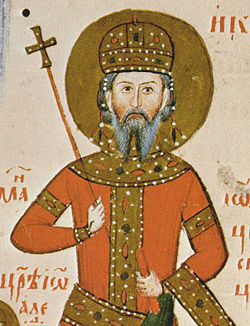 |
||
| Portrait of the tsar from the Tetraevangelia of Ivan Alexander | ||
| Reign | 1331–February 17, 1371 | |
| Died | February 17 1371 | |
| Predecessor | Ivan Stefan | |
| Successor | Ivan Šišman of Bulgaria Ivan Sracimir of Bulgaria |
|
| Consort | Theodora of Wallachia Sarah (Theodora) |
|
| Issue | see below | |
| Royal House | Šišman | |
| Father | Sracimir of Krǎn | |
| Mother | Petrica | |
Ivan Alexander (Bulgarian: Иван Александър, transliterated Ivan Aleksandǎr;[1] pronounced [iˈvan alɛkˈsandɤr]; original spelling: ІѠАНЪ АЛЄѮАНдРЪ),[2] also known as John Alexander, ruled as Emperor (Tsar) of Bulgaria from 1331 to 1371, during the Second Bulgarian Empire. The date of his birth is unknown. He died on February 17 1371. The long reign of Ivan Alexander is considered a transitional period in Bulgarian medieval history. Ivan Alexander began his rule by dealing with internal problems and external threats from Bulgaria's neighbors, the Byzantine Empire and Serbia, as well as leading his empire into a period of economic recovery and cultural and religious renaissance.
However, the emperor was later unable to cope with the mounting incursions of Ottoman forces, Hungarian invasions from the northwest and the Black Death. In an ill-fated attempt to combat these problems, he divided the country between his two sons, thus forcing it to face the imminent Ottoman conquest weakened and divided.
Ivan Alexander's rule was characterized as a second "Golden Age" for Bulgarian culture. It included the construction of churches and monastaries and a relative strengthening of the position of Christianity in the kingdom.
Early rule
Ivan Alexander was the son of the despotēs Sracimir of Krǎn by Petrica, a sister of Michael Asen III of Bulgaria.[3] Therefore, Ivan Alexander was a nephew of Michael Asen III.[4][5] Paternally, Ivan Alexander descended from the Asen dynasty.[4] [5] By 1330 Ivan Alexander was himself a despotēs and governed the city of Loveč. Together with his father and his father-in-law Basarab of Wallachia, Ivan Alexander fought in the Battle of Velbǎžd against the Serbs at modern-day Kjustendil in 1330, in which Bulgaria suffered defeat. The defeat, combined with the worsening relations with the Byzantine Empire, precipitated an internal crisis, which was exacerbated by an invasion of the Byzantines. A coup d'état drove Ivan Stefan out of the capital Tǎrnovo in 1331, and the conspirators placed Ivan Alexander on the throne.[6]
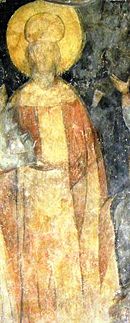
The new ruler set about consolidating his position by regaining territories recently lost to the Byzantine Empire. In 1331 Ivan Alexander campaigned around Adrianople and reconquered northeastern Thrace.[4][5] Meanwhile, Stefan Uroš IV Dušan deposed his father Stefan Uroš III Dečanski and became Serbian king in 1331. This helped normalize the previously tense relations between the two countries. Ivan Alexander and Stefan Uroš IV Dušan concluded an alliance, which was cemented by the marriage of the Serbian king to Helena of Bulgaria, a sister of Ivan Alexander, on Easter 1332.[4][5][7]
At about the same time, Belaur, a brother of Michael Asen III, rebelled in Vidin, probably in support of his deposed nephew Ivan Stefan's claim to the throne. The advance of the Byzantine Emperor Andronikos III Palaiologos against Bulgaria in the summer of 1332 protracted military operations against the rebels. The Byzantines overran Bulgarian-controlled northeastern Thrace, but Ivan Alexander rushed southward with a small army and swiftly caught up with Andronikos III at Rusokastro.[7]
| “ | Nobody of our first tsars seems to us like this great tsar Ivan Alexander, in his military power he looks to us like a second ancient Alexander the Great, in faith and piety he is a second Saint Constantine; he captured thus all his enemies, put them under his knees and established firm peace in the Universe.[8]Praise to Ivan Alexander by an anonymous contemporary of the tsar | ” |
After giving the impression that he wished to negotiate, Ivan Alexander, reinforced by Mongol cavalry, overwhelmed the smaller but better organized Byzantine army in the Battle of Rusokastro.[5] The contested cities surrendered to Ivan Alexander, while Andronikos III sought refuge within the walls of Rusokastro. The war ended when Ivan Alexander met Andronikos and concluded a peace agreement based on the status quo. To seal the alliance, he betrothed his eldest son, Michael Asen IV, to Andronikos's daughter Maria (Eirene), the marriage eventually taking place in 1339.[5][9] The Bulgarian emperor was now free to turn his attentions to Belaur, but it was not until 1336 or 1337 that the rebellion in the northwest was put down.[10]
In about 1332 Ivan Alexander had crowned his eldest son Michael Asen IV co-emperor, perhaps to safeguard possession of the throne by his own family. He followed up this traditional association with the coronation of his younger sons Ivan Sracimir and Ivan Asen IV in 1337. Ivan Alexander may have intended the creation of two younger co-emperors to establish immediate control over important cities and regions, as Ivan Sracimir was eventually based in Vidin, and Ivan Asen IV perhaps in Preslav. Nevertheless, this was a marked departure from Byzantine practice, in which younger sons of the sovereign were made despotēs, whether they were charged with a territorial administration or not.[11]
Relations with the Byzantine Empire
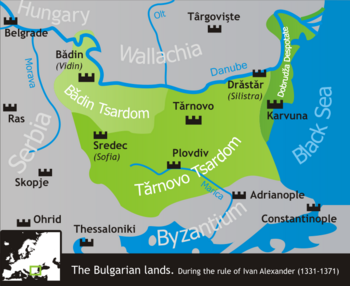
In the early 1340s relations with the Byzantine Empire temporarily deteriorated. Ivan Alexander demanded the extradition of his cousin Šišman, one of the sons of Michael Asen III, threatening the Byzantine government with war. Ivan Alexander's show of force backfired, as the Byzantines managed to see through his intentions and sent against him the fleet of their ally, the Turkish emir of Smyrna Umur Beg. Landing in the Danube Delta, the Turks of Umur Beg pillaged the countryside and attacked nearby Bulgarian cities. Forced to restrain his demands, Ivan Alexander invaded the Byzantine Empire again at the end of 1341, claiming that he was summoned by the people of Adrianople.[13] However, Ivan Alexander's troops were defeated twice by Turkish allies of the Byzantines near the city.[14]
In 1341–1347 the Byzantine Empire was plunged into a protracted civil war between the regency for Emperor John V Palaiologos under Anna of Savoy and his intended guardian John VI Kantakouzenos. The neighbors of the Byzantines took advantage of the civil war, and while Stefan Uroš IV Dušan of Serbia sided with John VI Kantakouzenos, Ivan Alexander backed John V Palaiologos and his regency.[5] Although the two Balkan rulers picked opposite sides in the Byzantine civil war, they maintained their alliance with each other. As the price for Ivan Alexander's support, the regency for John V Palaiologos ceded him the city of Philippopolis (Plovdiv) and nine important fortresses in the Rhodope Mountains in 1344.[15][16] This peaceful turnover constituted the last major success of Ivan Alexander's foreign policy.
Rise of Serbia and the Ottoman threat
- See also: Serbian Empire , Rise of the Ottoman Empire , and Bulgarian-Ottoman Wars
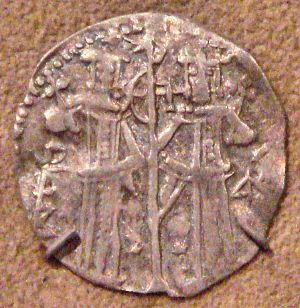
During the same period, the Serbian king took advantage of the Byzantine civil war to take possession of what is now Macedonia, and of most of Albania and northern Greece. In 1345 he began to call himself "Emperor of Serbs and Greeks," and in 1346 he was crowned as such by the newly created Patriarch of Serbia.[5] These actions, which the Byzantines received with indignation, appear to have been supported by Bulgaria, as the Patriarch of Bulgaria Simeon had participated in both the creation of a Serbian patriarchate and the imperial coronation of Stefan Uroš IV Dušan.[17]
By the second half of the 1340s, little remained of Ivan Alexander's initial successes. John VI Kantakouzenos' Turkish allies pillaged parts of Bulgarian Thrace in 1346, 1347, 1349, 1352 and 1354, to which were added the ravages of the Black Death.[18] The Bulgarians' attempts to repel the invaders met with repeated failure, and Ivan Alexander's third son and co-emperor, Ivan Asen IV, was killed in battle against the Turks in 1349, as was his older brother Michael Asen IV in 1355 or a little earlier.[19]
By 1351 the Byzantine civil war was over, and John VI Kantakouzenos had realized the threat posed by the Ottomans to the Balkan Peninsula. He appealed to the rulers of Serbia and Bulgaria for a united effort against the Turks and asked Ivan Alexander for money to construct warships,[5][20] but his appeals fell on deaf ears as his neighbors distrusted his intentions.[21] A new attempt for cooperation between Bulgaria and the Byzantine Empire followed in 1355,[22] after John VI Kantakouzenos had been forced to abdicate and John V Palaiologos had been established as supreme emperor. To cement the treaty, Ivan Alexander's daughter Keraca Marija[23] was married off to the future Byzantine Emperor Andronikos IV Palaiologos,[15] but the alliance failed to produce concrete results.[24]
Further stability problems and external conflicts

At home Ivan Alexander compromised the internal stability of his realm by divorcing his first wife Theodora of Wallachia (in about 1349) and marrying a converted Jew, also named Theodora.[5] The new marriage produced new sons, whom Ivan Alexander proceeded to crown co-emperors, Ivan Šišman in about 1356 and Ivan Asen V by 1359. Ivan Alexander's last surviving son from his first marriage, the co-emperor Ivan Sracimir, became effectively independent around 1356;[5] and Ivan Alexander's control over other powerful vassals, such as the rulers of Wallachia and Dobruja, who pursued their own foreign policies, was hardly stronger.[25]
From the middle of the fourteenth century, Bulgaria fell prey to the aspirations of the Angevin king Louis I of Hungary, who annexed Moldavia in 1352 and established a vassal principality there, before conquering Vidin in 1365,[5][20] and taking Ivan Sratsimir and his family into captivity.[5][25]
In the meantime Bulgarians and Byzantines had clashed again in 1364. In 1366, when Emperor John V Palaiologos was returning from his trip to the west, the Bulgarians refused to let him pass through Bulgaria. This stance backfired, as another Byzantine ally, Count Amadeus VI of Savoy, captured several Bulgarian maritime cities in retaliation, including Ankhialos (Pomorie) and Mesembria (Nesebǎr), though he failed to take Varna. Outmaneuvered, Ivan Alexander was forced to make peace.[26]
The captured cities were turned over to the Byzantine Empire, while Emperor John V Palaiologos paid the sum of 180,000 florins to Ivan Alexander.[5] The Bulgarian emperor used this sum and territorial concessions to induce his at least de jure vassals Dobrotica of Dobruja[27] and Vladislav I of Wallachia[28] to reconquer Vidin from the Hungarians.[29] The war was successful, and Ivan Sracimir was reinstalled in Vidin in 1369, although the Hungarian king forced him to acknowledge his overlordship.[30]
The relatively successful resolution of the crisis in the northwest did nothing to help recover the losses in the southeast. To make matters worse, in 1369 (the date is disputed), the Ottoman Turks under Murad I conquered Adrianople (in 1363) and made it the effective capital of their expanding state. At the same time, they also captured the Bulgarian cities of Philippopolis and Boruj (Stara Zagora).[31] As Bulgaria and the Serbian princes in Macedonia prepared for united action against the Turks, Ivan Alexander died on February 17, 1371.[32] He was succeeded by his sons Ivan Sracimir in Vidin[20] and Ivan Šišman in Tǎrnovo,[20] while the rulers of Dobruja and Wallachia achieved further independence.
Culture and religion
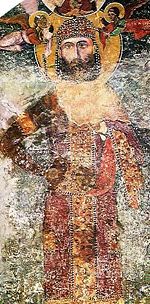
During Ivan Alexander's rule, the Second Bulgarian Empire entered a period of cultural renaissance, which is sometimes referred to as the "Second Golden Age of Bulgarian culture;"[33] the original Golden Age came during the rule of Simeon the Great. A large number of Bulgarian monasteries and churches were constructed or renovated on the order of Ivan Alexander.[15][34] Mural portraits of him as a donor can be seen in the Bachkovo Monastery's ossuary and in the Rock-hewn Churches of Ivanovo. Donor's deeds of Ivan Alexander prove that the monasteries of the Holy Mother of God Eleoussa and Saint Nicholas in Nesebǎr were reconstructed during that period,[5] as was the St Nicholas monastery near Pernik, according to a Hilandar monastery deed. In addition, the tsar also initiated the construction of the Dragalevci and Kilifarevo monasteries.[5]
Literary activity also flourished during the reign of Ivan Alexander. Several important literary works were created in the period, such as the Middle Bulgarian translation of the Manasses Chronicle (1344–1345), currently preserved in the Vatican Secret Archives in Rome,[5]the richly illustrated Tetraevangelia of Ivan Alexander (1355–1356), now exhibited in the British Library, the Tomić Psalter (1360), today in Moscow,[5] and the Sofia Psalter (1337).
Ivan Alexander's rule was also marked by efforts to strengthen the position of the Bulgarian Orthodox Church by pursuing heretics and Jews.[35] He organized two anti-heretical church councils, in 1350 and 1359–1360, that condemned various sects[5][35] such as the Bogomils, the Adamites and the Judaizers.[5][36]
The spiritual practice of hesychasm, a form of incantatory prayer, deeply influenced certain areas of the Eastern Orthodox world of the fourteenth century. A notable Bulgarian representative of the movement during Ivan Alexander's reign was Theodosius of Tǎrnovo.
During this time, the Bulgarian Empire had trade relations with the Mediterranean maritime powers Venice, Genoa and Ragusa.[37] In 1353, Ivan Alexander issued a charter allowing Venetian merchants to buy and sell goods throughout Bulgaria after Doge Andrea Dandolo assured him they would observe the prior treaties between the two countries.[38]
Family
By his first wife Theodora of Wallachia (nun Teofana), a daughter of Basarab of Wallachia, Ivan Alexander had several children, including Ivan Sracimir, who ruled as emperor of Bulgaria in Vidin 1356–1397, associated emperors Michael Asen IV (co-ruled c. 1332–1354/1355) and Ivan Asen IV (co-ruled 1337–1349), and a daughter called Thamar (Kera Tamara), who was married first to the despotēs Constantine (Konstantin), and then to Sultan Murad I[39] of the Ottoman Empire.[3]
By his second wife Sarah-Theodora, Ivan Alexander had several other children, which included Keraca Marija, who married the Byzantine Emperor Andronikos IV Palaiologos, Ivan Šišman, who succeeded as emperor of Bulgaria in Tǎrnovo 1371–1396, Ivan Asen V, associated as emperor of Bulgaria by 1359–1388?, as well as two daughters named Desislava and Vasilisa.[3]
Legacy
In modern times, the rule of Ivan Alexander inspired Bulgarian national writer Ivan Vazov to write the novelette Ivan-Aleksandǎr and the drama Kǎm propast (Towards an Abyss), in both of which the tsar is the main character.
A piece of a garment signed by Ivan Alexander and interwoven with gold was discovered in a noble's grave near Pirot in the 1970s; today it is preserved in the National Museum of Serbia in Belgrade. It is the first find of its kind, demonstrating a medieval tradition attested in writing according to which Orthodox rulers would present their most eminent dignitaries with a piece of a garment they had worn.
| Sracimir of Krǎn | Petrica | ||||||||
| 1 | 2 | ||||||||
| Theodora of Wallachia | Ivan Alexander (d. 1371, ruled 1331–1371) |
Sarah (Theodora) | |||||||
| 1 | 1 | 1 | 1 | 2 | 2 | 2 | 2 | 2 | |
| Michael Asen IV | Thamar (Kera Tamara) | Ivan Šišman (b. 1350–1351, d. 1395, ruled 1371–1395) |
Ivan Asen V | Vasilisa | |||||
| Ivan Asen IV | Ivan Sracimir (b. c. 1324, d. c. 1397, ruled 1356–1397) |
Keraca Marija (b. 1348, d. 1390) |
Desislava | ||||||
Timeline
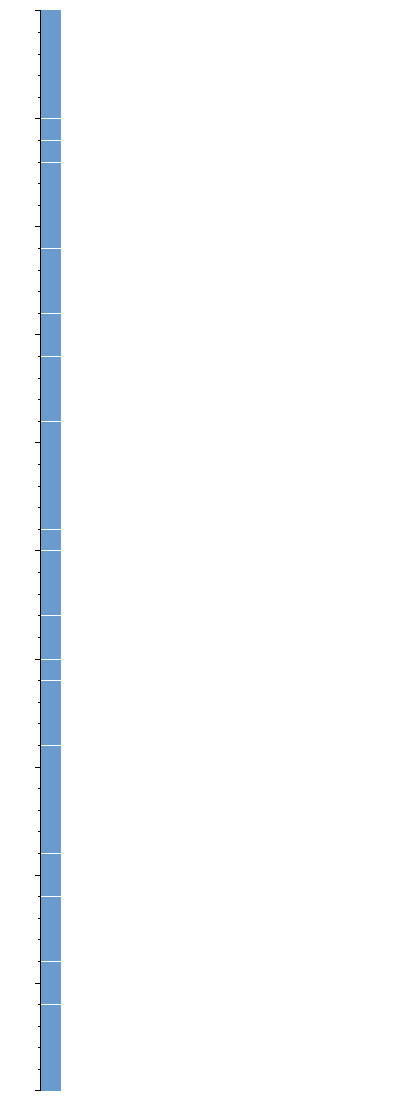
Notes
- ↑ This article uses the United Nations-authorized scientific transliteration system to romanize Bulgarian Cyrillic. For details, see Romanization of Bulgarian.
- ↑ As spelled in the Zograf and Orjahov Charters. Angelina Daskalova and Marija Rajkova. Gramoti na bǎlgarskite care. (Sofia: Bulgarian Academy of Sciences, 2005. ISBN 9543220344), 58–59. (Bulgarian)
- ↑ 3.0 3.1 3.2 3.3 Ivan Božilov. (1985). Familijata na Asenevci (1186–1460). (in Bulgarian). (Sofia: Bulgarian Academy of Sciences), 192–235.
- ↑ 4.0 4.1 4.2 4.3 Bǎlgarite i Bǎlgarija, 2.1
- ↑ 5.00 5.01 5.02 5.03 5.04 5.05 5.06 5.07 5.08 5.09 5.10 5.11 5.12 5.13 5.14 5.15 5.16 5.17 5.18 5.19 Delev, Istorija i civilizacija za 11. klas
- ↑ John V.A. Fine, Jr. (1987). The Late Medieval Balkans. (Ann Arbor: University of Michigan Press. ISBN 0472082604), 273.
- ↑ 7.0 7.1 Fine, 274.
- ↑ Originally from the Sofia Psalter, folios 311a-312b. Adapted by Stefan Canev, (2006). "11 Kǎm propast. Car Ivan Aleksandǎr, Momčil," in Bǎlgarski hroniki. (in Bulgarian). (Sofia, Plovdiv: Trud, Žanet 45. ISBN 9545286105), 459–460.
- ↑ Božilov, Familijata na Asenevci, 192–197.
- ↑ Jordan Andreev, (1993). Bǎlgarija prez vtorata četvǎrt na XIV v. (in Bulgarian). (Veliko Tǎrnovo: Sv. Kliment Ohridski. OCLC 69163573.), 33–41.
- ↑ Andreev, 23–52.
- ↑ Based on Lalkov, Rulers of Bulgaria
- ↑ Georgi Bakalov and Milen Kumanov (2003). "Esenta, 1341 g." in Elektronno izdanie – Istorija na Bǎlgarija. (in Bulgarian). (Sofia: Trud, Sirma. ISBN 9844830679.)
- ↑ Fine, 292–293.
- ↑ 15.0 15.1 15.2 Lalkov, Rulers of Bulgaria, 42–43.
- ↑ Fine, 304.
- ↑ Fine, 309–310.
- ↑ Fine, 322, 325, 328.
- ↑ Andreev, 67–75.
- ↑ 20.0 20.1 20.2 20.3 Bǎlgarite i Bǎlgarija, 2.2
- ↑ Fine, 325.
- ↑ Bakalov, Istorija na Bǎlgarija, "1355 g."
- ↑ 23.0 23.1 Ivan Božilov and asil Gjuzelev. Istorija na srednovekovna Bǎlgarija VII-XIV vek (tom 1).' (Anubis: 2006. ISBN 9544262040) (in Bulgarian)
- ↑ Božilov, Familijata na Asenevci, 218–224.
- ↑ 25.0 25.1 Fine, 366.
- ↑ Fine, 367.
- ↑ Bakalov, Istorija na Bǎlgarija, "Dobrotica (neizv.–okolo 1385)"
- ↑ Petǎr Koledarov. Političeska geografija na srednovekovnata bǎlgarska dǎržava 2 (1186–1396). (Bulgarian Academy of Sciences, 1989), 13–25, 102 (Bulgarian)
- ↑ Bakalov, Istorija na Bǎlgarija, "Esenta, 1369 g."
- ↑ Fine, 367–368.
- ↑ Tjutjundžiev and Pavlov, Bǎlgarskata dǎržava i osmanskata ekspanzija
- ↑ Fine, 368.
- ↑ Petǎr Kǎnev, Religion in Bulgaria after 1989, [1], South-East Europe Review 1 (2002):81. Retrieved December 18, 2008.
- ↑ Sinodik na Car Boril, additions from the 13th and 14th century, cited in Canev, Bǎlgarski hroniki, p. 456.
- ↑ 35.0 35.1 The Virtual Jewish History Tour Bulgaria. Jewish Virtual Library accessdate December 18, 2008
- ↑ Canev, Bǎlgarski hroniki, 457.
- ↑ "Ivan Aleksandǎr Asen (?–1371)" Bǎlgarska enciklopedija A-JA – treto osǎvremeneno izdanie. (Sofia: Trud, Sirma, 2005. ISBN 9545285192) (Bulgarian)
- ↑ Bakalov, Istorija na Bǎlgarija, "Venecianska gramota"
- ↑ Pete Sugar. Southeastern Europe Under Ottoman Rule, 1354–1804. (University of Washington Press, 1983. ISBN 0295960337), 16
References
ISBN links support NWE through referral fees
- Andreev, Jordan and Ivan Lazarov, Plamen Pavlov (1999). Koj koj e v srednovekovna Bǎlgarija, 2nd edition. (in Bulgarian), Sofia: Petǎr Beron. ISBN 9544020470.
- Andreev, Jordan (1993). Bǎlgarija prez vtorata četvǎrt na XIV v. (in Bulgarian). Veliko Tǎrnovo: Sv. Kliment Ohridski. OCLC 69163573.
- Angelov, Petǎr [1978] (1982). Bǎlgaro-srǎbskite otnošenija pri caruvaneto na Ivan Aleksandǎr (1331-1371) i Stefan Dušan (1331-1355. (in Bulgarian). Sofia: Sofia University Press.
- Bakalov, Georgi, and Milen Kumanov (2003). Elektronno izdanie – Istorija na Bǎlgarija. (in Bulgarian). Sofia: Trud, Sirma. ISBN 9844830679.
- Božilov, Ivan (1985). Familijata na Asenevci (1186–1460). (in Bulgarian). Sofia: Bulgarian Academy of Sciences. OCLC 14378091.
- Canev, Stefan (2006). "11 Kǎm propast. Car Ivan Aleksandǎr, Momčil," Bǎlgarski hroniki. (in Bulgarian). Sofia, Plovdiv: Trud, Žanet 45. ISBN 9545286105.
- Delev, Petǎr, and Valeri Kacunov, Plamen Mitev, Evgenija Kalinova, Iskra Baeva, Bojan Dobrev (2006). "19 Bǎlgarija pri Car Ivan Aleksandǎr," Istorija i civilizacija za 11. klas. (in Bulgarian). Trud, Sirma.
- Daskalova, Angelina, and Marija Rajkova. Gramoti na bǎlgarskite care. Sofia: Bulgarian Academy of Sciences, 2005. ISBN 9543220344. (in Bulgarian)
- Fine, Jr., John V.A. (1987). The Late Medieval Balkans. Ann Arbor: University of Michigan Press. ISBN 0472082604.
- Koledarov, Petǎr. Političeska geografija na srednovekovnata bǎlgarska dǎržava 2 (1186–1396). Bulgarian Academy of Sciences, 1989., 13–25, 102 (Bulgarian).
- Lalkov, Milčo. (1997) 2003. "Tsar Ivan Alexander (1331–1371)," in Rulers of Bulgaria. All the Khans, Tsars, and Statesmen of Bulgaria, ed. D. Draganov. Kibea: ISBN 9544740988. (a Children's Encyclopedia of all 32 Rulers of Bulgarian history) (in English)
- Sugar, Pete (1983). Southeastern Europe Under Ottoman Rule, 1354–1804. University of Washington Press. ISBN 0295960337. (in English)
- Tjutjundžiev, Ivan, and Plamen Pavlov (1992). Bǎlgarskata dǎržava i osmanskata ekspanzija 1369–1422. (in Bulgarian). OCLC 29671645.
External links
All links retrieved March 10, 2018.
- Images of Tsar Ivan Alexander from the 14th century
|
||||||||||||||||||||||
| Preceded by: Ivan Stefan |
Emperor of Bulgaria 1331–1371 |
Succeeded by: Ivan Sracimir and Ivan Šišman |
Credits
New World Encyclopedia writers and editors rewrote and completed the Wikipedia article in accordance with New World Encyclopedia standards. This article abides by terms of the Creative Commons CC-by-sa 3.0 License (CC-by-sa), which may be used and disseminated with proper attribution. Credit is due under the terms of this license that can reference both the New World Encyclopedia contributors and the selfless volunteer contributors of the Wikimedia Foundation. To cite this article click here for a list of acceptable citing formats.The history of earlier contributions by wikipedians is accessible to researchers here:
- Ivan Alexander of Bulgaria history
The history of this article since it was imported to New World Encyclopedia:
- History of "Ivan Alexander of Bulgaria"
Note: Some restrictions may apply to use of individual images which are separately licensed.
↧ Download as ZWI file | Last modified: 02/04/2023 06:27:07 | 4 views
☰ Source: https://www.newworldencyclopedia.org/entry/Ivan_Alexander_of_Bulgaria | License: CC BY-SA 3.0
 ZWI signed:
ZWI signed: KSF
KSF